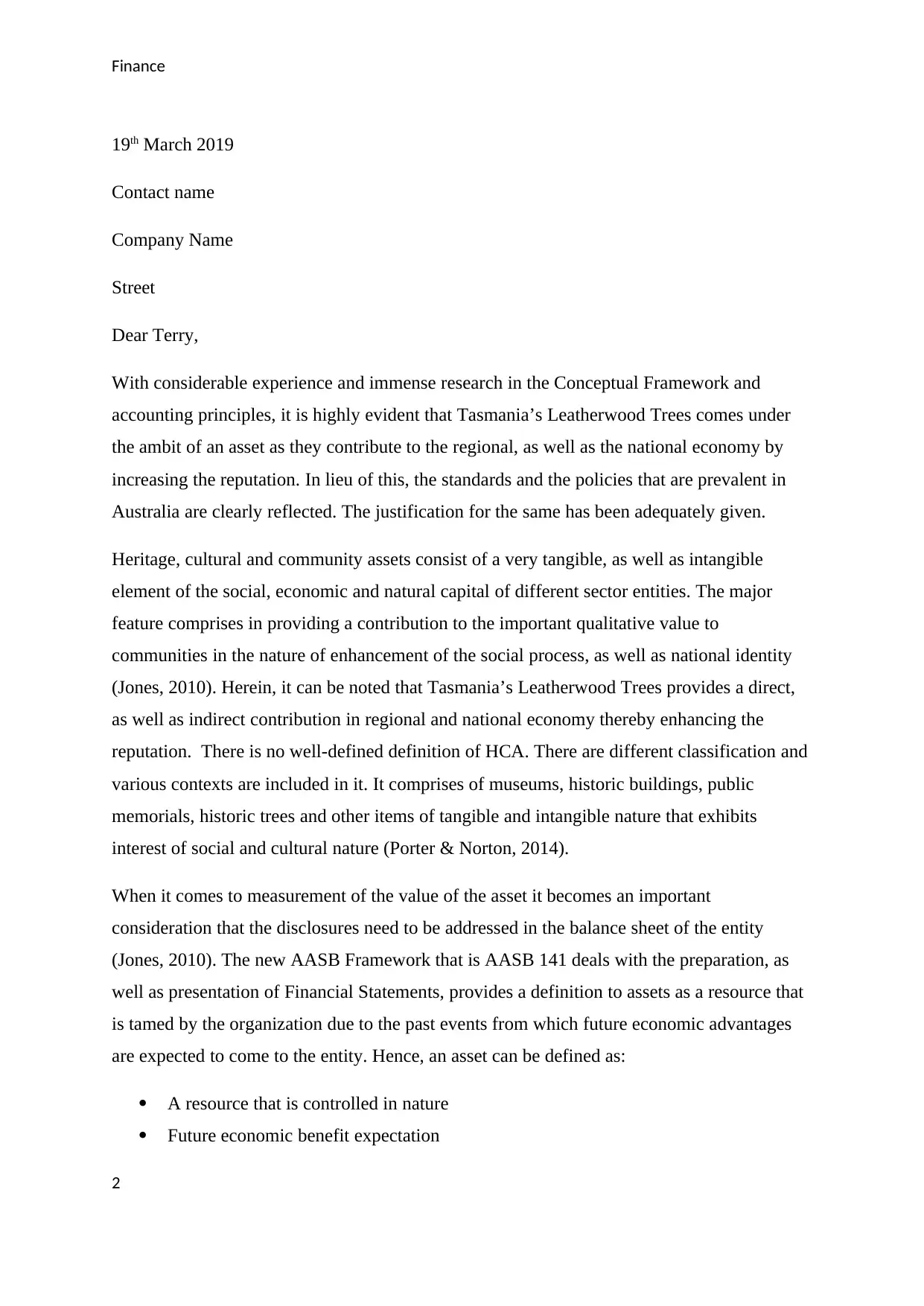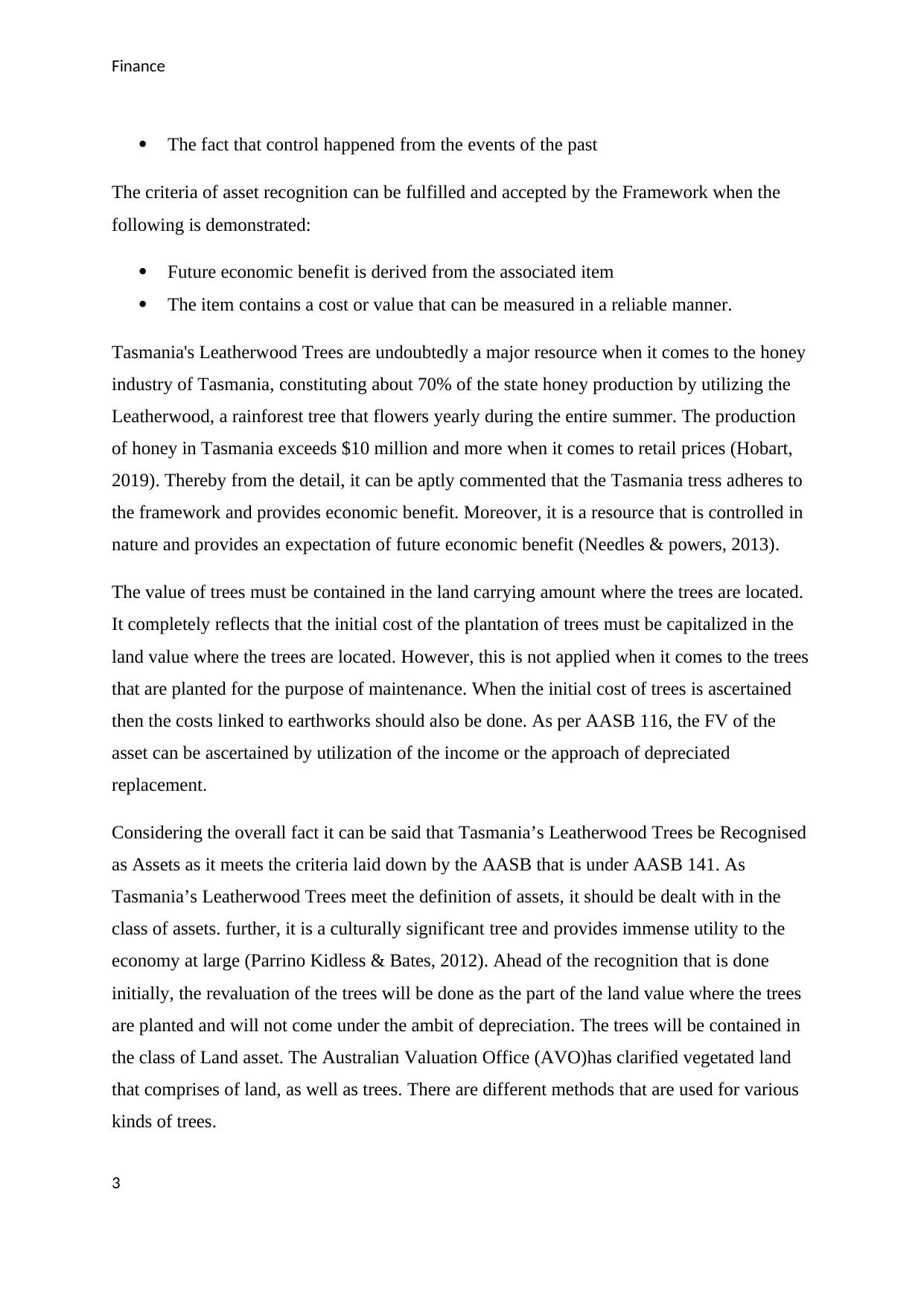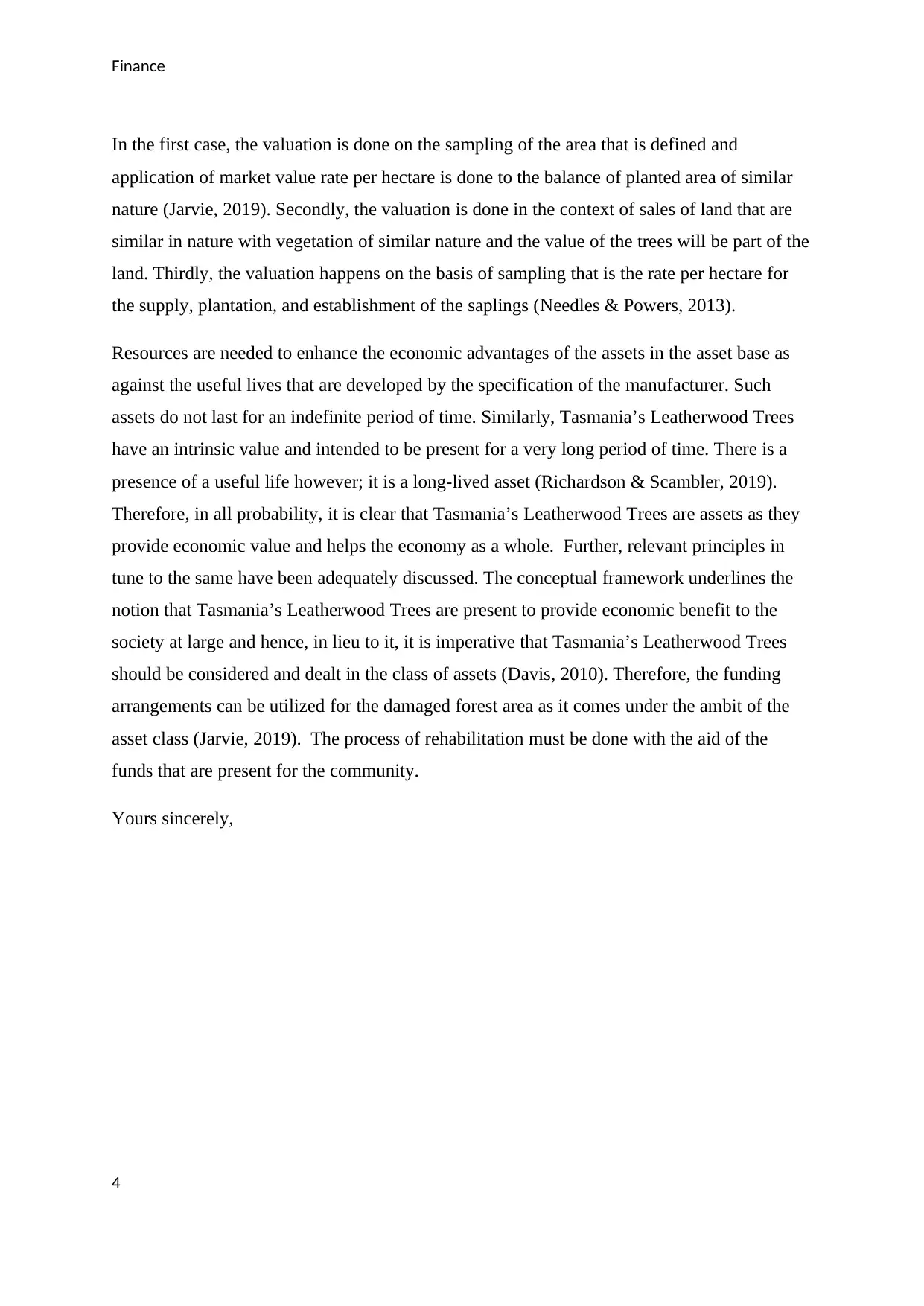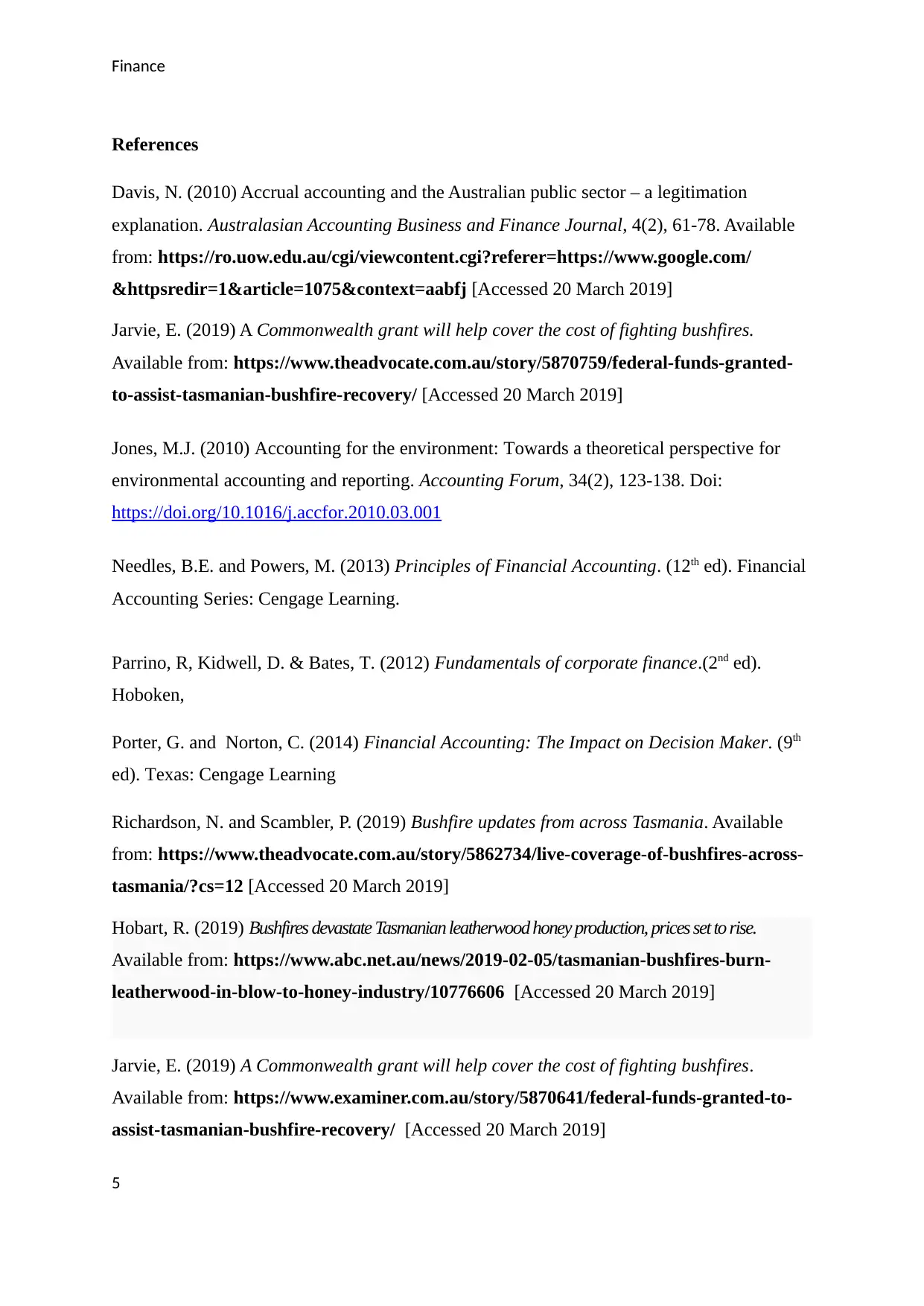BFA605 Finance Case Study: Should Leatherwood Trees Be Assets?
VerifiedAdded on 2023/04/08
|5
|1235
|142
Case Study
AI Summary
This case study examines whether Tasmania's Leatherwood Trees should be recognized as assets under accounting standards, particularly AASB 141. The analysis considers the trees' economic contribution to the Tasmanian honey industry, their role as a resource, and their potential for future economic benefits. The study assesses whether the trees meet the criteria for asset recognition, including control, future economic benefit, and reliable measurement. It also discusses valuation methods, such as land value assessment, and addresses the trees' cultural significance and long-term economic value. The conclusion supports recognizing the Leatherwood Trees as assets, emphasizing their importance to the Tasmanian economy and the need for appropriate accounting treatment and funding for rehabilitation efforts in damaged areas. The document highlights the importance of the conceptual framework in determining the economic benefit of the Leatherwood Trees to the society.

qwertyuiopasdfghjklzxcvbnmqwerty
uiopasdfghjklzxcvbnmqwertyuiopasd
fghjklzxcvbnmqwertyuiopasdfghjklzx
cvbnmqwertyuiopasdfghjklzxcvbnmq
wertyuiopasdfghjklzxcvbnmqwertyui
opasdfghjklzxcvbnmqwertyuiopasdfg
hjklzxcvbnmqwertyuiopasdfghjklzxc
vbnmqwertyuiopasdfghjklzxcvbnmq
wertyuiopasdfghjklzxcvbnmqwertyui
opasdfghjklzxcvbnmqwertyuiopasdfg
hjklzxcvbnmqwertyuiopasdfghjklzxc
vbnmqwertyuiopasdfghjklzxcvbnmq
wertyuiopasdfghjklzxcvbnmqwertyui
opasdfghjklzxcvbnmqwertyuiopasdfg
hjklzxcvbnmrtyuiopasdfghjklzxcvbn
mqwertyuiopasdfghjklzxcvbnmqwert
yuiopasdfghjklzxcvbnmqwertyuiopas
Financial and corporate accounting
uiopasdfghjklzxcvbnmqwertyuiopasd
fghjklzxcvbnmqwertyuiopasdfghjklzx
cvbnmqwertyuiopasdfghjklzxcvbnmq
wertyuiopasdfghjklzxcvbnmqwertyui
opasdfghjklzxcvbnmqwertyuiopasdfg
hjklzxcvbnmqwertyuiopasdfghjklzxc
vbnmqwertyuiopasdfghjklzxcvbnmq
wertyuiopasdfghjklzxcvbnmqwertyui
opasdfghjklzxcvbnmqwertyuiopasdfg
hjklzxcvbnmqwertyuiopasdfghjklzxc
vbnmqwertyuiopasdfghjklzxcvbnmq
wertyuiopasdfghjklzxcvbnmqwertyui
opasdfghjklzxcvbnmqwertyuiopasdfg
hjklzxcvbnmrtyuiopasdfghjklzxcvbn
mqwertyuiopasdfghjklzxcvbnmqwert
yuiopasdfghjklzxcvbnmqwertyuiopas
Financial and corporate accounting
Paraphrase This Document
Need a fresh take? Get an instant paraphrase of this document with our AI Paraphraser

Finance
19th March 2019
Contact name
Company Name
Street
Dear Terry,
With considerable experience and immense research in the Conceptual Framework and
accounting principles, it is highly evident that Tasmania’s Leatherwood Trees comes under
the ambit of an asset as they contribute to the regional, as well as the national economy by
increasing the reputation. In lieu of this, the standards and the policies that are prevalent in
Australia are clearly reflected. The justification for the same has been adequately given.
Heritage, cultural and community assets consist of a very tangible, as well as intangible
element of the social, economic and natural capital of different sector entities. The major
feature comprises in providing a contribution to the important qualitative value to
communities in the nature of enhancement of the social process, as well as national identity
(Jones, 2010). Herein, it can be noted that Tasmania’s Leatherwood Trees provides a direct,
as well as indirect contribution in regional and national economy thereby enhancing the
reputation. There is no well-defined definition of HCA. There are different classification and
various contexts are included in it. It comprises of museums, historic buildings, public
memorials, historic trees and other items of tangible and intangible nature that exhibits
interest of social and cultural nature (Porter & Norton, 2014).
When it comes to measurement of the value of the asset it becomes an important
consideration that the disclosures need to be addressed in the balance sheet of the entity
(Jones, 2010). The new AASB Framework that is AASB 141 deals with the preparation, as
well as presentation of Financial Statements, provides a definition to assets as a resource that
is tamed by the organization due to the past events from which future economic advantages
are expected to come to the entity. Hence, an asset can be defined as:
A resource that is controlled in nature
Future economic benefit expectation
2
19th March 2019
Contact name
Company Name
Street
Dear Terry,
With considerable experience and immense research in the Conceptual Framework and
accounting principles, it is highly evident that Tasmania’s Leatherwood Trees comes under
the ambit of an asset as they contribute to the regional, as well as the national economy by
increasing the reputation. In lieu of this, the standards and the policies that are prevalent in
Australia are clearly reflected. The justification for the same has been adequately given.
Heritage, cultural and community assets consist of a very tangible, as well as intangible
element of the social, economic and natural capital of different sector entities. The major
feature comprises in providing a contribution to the important qualitative value to
communities in the nature of enhancement of the social process, as well as national identity
(Jones, 2010). Herein, it can be noted that Tasmania’s Leatherwood Trees provides a direct,
as well as indirect contribution in regional and national economy thereby enhancing the
reputation. There is no well-defined definition of HCA. There are different classification and
various contexts are included in it. It comprises of museums, historic buildings, public
memorials, historic trees and other items of tangible and intangible nature that exhibits
interest of social and cultural nature (Porter & Norton, 2014).
When it comes to measurement of the value of the asset it becomes an important
consideration that the disclosures need to be addressed in the balance sheet of the entity
(Jones, 2010). The new AASB Framework that is AASB 141 deals with the preparation, as
well as presentation of Financial Statements, provides a definition to assets as a resource that
is tamed by the organization due to the past events from which future economic advantages
are expected to come to the entity. Hence, an asset can be defined as:
A resource that is controlled in nature
Future economic benefit expectation
2

Finance
The fact that control happened from the events of the past
The criteria of asset recognition can be fulfilled and accepted by the Framework when the
following is demonstrated:
Future economic benefit is derived from the associated item
The item contains a cost or value that can be measured in a reliable manner.
Tasmania's Leatherwood Trees are undoubtedly a major resource when it comes to the honey
industry of Tasmania, constituting about 70% of the state honey production by utilizing the
Leatherwood, a rainforest tree that flowers yearly during the entire summer. The production
of honey in Tasmania exceeds $10 million and more when it comes to retail prices (Hobart,
2019). Thereby from the detail, it can be aptly commented that the Tasmania tress adheres to
the framework and provides economic benefit. Moreover, it is a resource that is controlled in
nature and provides an expectation of future economic benefit (Needles & powers, 2013).
The value of trees must be contained in the land carrying amount where the trees are located.
It completely reflects that the initial cost of the plantation of trees must be capitalized in the
land value where the trees are located. However, this is not applied when it comes to the trees
that are planted for the purpose of maintenance. When the initial cost of trees is ascertained
then the costs linked to earthworks should also be done. As per AASB 116, the FV of the
asset can be ascertained by utilization of the income or the approach of depreciated
replacement.
Considering the overall fact it can be said that Tasmania’s Leatherwood Trees be Recognised
as Assets as it meets the criteria laid down by the AASB that is under AASB 141. As
Tasmania’s Leatherwood Trees meet the definition of assets, it should be dealt with in the
class of assets. further, it is a culturally significant tree and provides immense utility to the
economy at large (Parrino Kidless & Bates, 2012). Ahead of the recognition that is done
initially, the revaluation of the trees will be done as the part of the land value where the trees
are planted and will not come under the ambit of depreciation. The trees will be contained in
the class of Land asset. The Australian Valuation Office (AVO)has clarified vegetated land
that comprises of land, as well as trees. There are different methods that are used for various
kinds of trees.
3
The fact that control happened from the events of the past
The criteria of asset recognition can be fulfilled and accepted by the Framework when the
following is demonstrated:
Future economic benefit is derived from the associated item
The item contains a cost or value that can be measured in a reliable manner.
Tasmania's Leatherwood Trees are undoubtedly a major resource when it comes to the honey
industry of Tasmania, constituting about 70% of the state honey production by utilizing the
Leatherwood, a rainforest tree that flowers yearly during the entire summer. The production
of honey in Tasmania exceeds $10 million and more when it comes to retail prices (Hobart,
2019). Thereby from the detail, it can be aptly commented that the Tasmania tress adheres to
the framework and provides economic benefit. Moreover, it is a resource that is controlled in
nature and provides an expectation of future economic benefit (Needles & powers, 2013).
The value of trees must be contained in the land carrying amount where the trees are located.
It completely reflects that the initial cost of the plantation of trees must be capitalized in the
land value where the trees are located. However, this is not applied when it comes to the trees
that are planted for the purpose of maintenance. When the initial cost of trees is ascertained
then the costs linked to earthworks should also be done. As per AASB 116, the FV of the
asset can be ascertained by utilization of the income or the approach of depreciated
replacement.
Considering the overall fact it can be said that Tasmania’s Leatherwood Trees be Recognised
as Assets as it meets the criteria laid down by the AASB that is under AASB 141. As
Tasmania’s Leatherwood Trees meet the definition of assets, it should be dealt with in the
class of assets. further, it is a culturally significant tree and provides immense utility to the
economy at large (Parrino Kidless & Bates, 2012). Ahead of the recognition that is done
initially, the revaluation of the trees will be done as the part of the land value where the trees
are planted and will not come under the ambit of depreciation. The trees will be contained in
the class of Land asset. The Australian Valuation Office (AVO)has clarified vegetated land
that comprises of land, as well as trees. There are different methods that are used for various
kinds of trees.
3
⊘ This is a preview!⊘
Do you want full access?
Subscribe today to unlock all pages.

Trusted by 1+ million students worldwide

Finance
In the first case, the valuation is done on the sampling of the area that is defined and
application of market value rate per hectare is done to the balance of planted area of similar
nature (Jarvie, 2019). Secondly, the valuation is done in the context of sales of land that are
similar in nature with vegetation of similar nature and the value of the trees will be part of the
land. Thirdly, the valuation happens on the basis of sampling that is the rate per hectare for
the supply, plantation, and establishment of the saplings (Needles & Powers, 2013).
Resources are needed to enhance the economic advantages of the assets in the asset base as
against the useful lives that are developed by the specification of the manufacturer. Such
assets do not last for an indefinite period of time. Similarly, Tasmania’s Leatherwood Trees
have an intrinsic value and intended to be present for a very long period of time. There is a
presence of a useful life however; it is a long-lived asset (Richardson & Scambler, 2019).
Therefore, in all probability, it is clear that Tasmania’s Leatherwood Trees are assets as they
provide economic value and helps the economy as a whole. Further, relevant principles in
tune to the same have been adequately discussed. The conceptual framework underlines the
notion that Tasmania’s Leatherwood Trees are present to provide economic benefit to the
society at large and hence, in lieu to it, it is imperative that Tasmania’s Leatherwood Trees
should be considered and dealt in the class of assets (Davis, 2010). Therefore, the funding
arrangements can be utilized for the damaged forest area as it comes under the ambit of the
asset class (Jarvie, 2019). The process of rehabilitation must be done with the aid of the
funds that are present for the community.
Yours sincerely,
4
In the first case, the valuation is done on the sampling of the area that is defined and
application of market value rate per hectare is done to the balance of planted area of similar
nature (Jarvie, 2019). Secondly, the valuation is done in the context of sales of land that are
similar in nature with vegetation of similar nature and the value of the trees will be part of the
land. Thirdly, the valuation happens on the basis of sampling that is the rate per hectare for
the supply, plantation, and establishment of the saplings (Needles & Powers, 2013).
Resources are needed to enhance the economic advantages of the assets in the asset base as
against the useful lives that are developed by the specification of the manufacturer. Such
assets do not last for an indefinite period of time. Similarly, Tasmania’s Leatherwood Trees
have an intrinsic value and intended to be present for a very long period of time. There is a
presence of a useful life however; it is a long-lived asset (Richardson & Scambler, 2019).
Therefore, in all probability, it is clear that Tasmania’s Leatherwood Trees are assets as they
provide economic value and helps the economy as a whole. Further, relevant principles in
tune to the same have been adequately discussed. The conceptual framework underlines the
notion that Tasmania’s Leatherwood Trees are present to provide economic benefit to the
society at large and hence, in lieu to it, it is imperative that Tasmania’s Leatherwood Trees
should be considered and dealt in the class of assets (Davis, 2010). Therefore, the funding
arrangements can be utilized for the damaged forest area as it comes under the ambit of the
asset class (Jarvie, 2019). The process of rehabilitation must be done with the aid of the
funds that are present for the community.
Yours sincerely,
4
Paraphrase This Document
Need a fresh take? Get an instant paraphrase of this document with our AI Paraphraser

Finance
References
Davis, N. (2010) Accrual accounting and the Australian public sector – a legitimation
explanation. Australasian Accounting Business and Finance Journal, 4(2), 61-78. Available
from: https://ro.uow.edu.au/cgi/viewcontent.cgi?referer=https://www.google.com/
&httpsredir=1&article=1075&context=aabfj [Accessed 20 March 2019]
Jarvie, E. (2019) A Commonwealth grant will help cover the cost of fighting bushfires.
Available from: https://www.theadvocate.com.au/story/5870759/federal-funds-granted-
to-assist-tasmanian-bushfire-recovery/ [Accessed 20 March 2019]
Jones, M.J. (2010) Accounting for the environment: Towards a theoretical perspective for
environmental accounting and reporting. Accounting Forum, 34(2), 123-138. Doi:
https://doi.org/10.1016/j.accfor.2010.03.001
Needles, B.E. and Powers, M. (2013) Principles of Financial Accounting. (12th ed). Financial
Accounting Series: Cengage Learning.
Parrino, R, Kidwell, D. & Bates, T. (2012) Fundamentals of corporate finance.(2nd ed).
Hoboken,
Porter, G. and Norton, C. (2014) Financial Accounting: The Impact on Decision Maker. (9th
ed). Texas: Cengage Learning
Richardson, N. and Scambler, P. (2019) Bushfire updates from across Tasmania. Available
from: https://www.theadvocate.com.au/story/5862734/live-coverage-of-bushfires-across-
tasmania/?cs=12 [Accessed 20 March 2019]
Hobart, R. (2019) Bushfires devastate Tasmanian leatherwood honey production, prices set to rise.
Available from: https://www.abc.net.au/news/2019-02-05/tasmanian-bushfires-burn-
leatherwood-in-blow-to-honey-industry/10776606 [Accessed 20 March 2019]
Jarvie, E. (2019) A Commonwealth grant will help cover the cost of fighting bushfires.
Available from: https://www.examiner.com.au/story/5870641/federal-funds-granted-to-
assist-tasmanian-bushfire-recovery/ [Accessed 20 March 2019]
5
References
Davis, N. (2010) Accrual accounting and the Australian public sector – a legitimation
explanation. Australasian Accounting Business and Finance Journal, 4(2), 61-78. Available
from: https://ro.uow.edu.au/cgi/viewcontent.cgi?referer=https://www.google.com/
&httpsredir=1&article=1075&context=aabfj [Accessed 20 March 2019]
Jarvie, E. (2019) A Commonwealth grant will help cover the cost of fighting bushfires.
Available from: https://www.theadvocate.com.au/story/5870759/federal-funds-granted-
to-assist-tasmanian-bushfire-recovery/ [Accessed 20 March 2019]
Jones, M.J. (2010) Accounting for the environment: Towards a theoretical perspective for
environmental accounting and reporting. Accounting Forum, 34(2), 123-138. Doi:
https://doi.org/10.1016/j.accfor.2010.03.001
Needles, B.E. and Powers, M. (2013) Principles of Financial Accounting. (12th ed). Financial
Accounting Series: Cengage Learning.
Parrino, R, Kidwell, D. & Bates, T. (2012) Fundamentals of corporate finance.(2nd ed).
Hoboken,
Porter, G. and Norton, C. (2014) Financial Accounting: The Impact on Decision Maker. (9th
ed). Texas: Cengage Learning
Richardson, N. and Scambler, P. (2019) Bushfire updates from across Tasmania. Available
from: https://www.theadvocate.com.au/story/5862734/live-coverage-of-bushfires-across-
tasmania/?cs=12 [Accessed 20 March 2019]
Hobart, R. (2019) Bushfires devastate Tasmanian leatherwood honey production, prices set to rise.
Available from: https://www.abc.net.au/news/2019-02-05/tasmanian-bushfires-burn-
leatherwood-in-blow-to-honey-industry/10776606 [Accessed 20 March 2019]
Jarvie, E. (2019) A Commonwealth grant will help cover the cost of fighting bushfires.
Available from: https://www.examiner.com.au/story/5870641/federal-funds-granted-to-
assist-tasmanian-bushfire-recovery/ [Accessed 20 March 2019]
5
1 out of 5
Related Documents
Your All-in-One AI-Powered Toolkit for Academic Success.
+13062052269
info@desklib.com
Available 24*7 on WhatsApp / Email
![[object Object]](/_next/static/media/star-bottom.7253800d.svg)
Unlock your academic potential
Copyright © 2020–2025 A2Z Services. All Rights Reserved. Developed and managed by ZUCOL.





